Punnett Squares are a mathematical technique for determining the inheritance of specific features from parent to progeny. Developed by Reginald C. Punnett, this technique may predict the likely outcomes of offspring with specific genotypes and phenotypes in accordance with Mendelian inheritance.
Genotype is an organism's genetic makeup or allelic mixture; genotypes are inherited features that carry hereditary information from either parent in a subsequent cross.
When paired with environmental factors, phenotypes are graphically expressed; examples of phenotypes are the traits we are looking for when utilizing the Punnett square tool.
Before you begin filling up a Punnett square, let's define some terminology;
Phenotype: Phenotype is the set of traits that can be observed on the individual. Phenotype is determined by genotype (and in real-world cases, environment).
Genotype: Genotype is the underlying genetic code that results in the phenotype. Genotypes are not expressed, only phenotypes are expressed.
Allele: One of two or more variations on a specific gene.
Dominant: When one allele will preferentially express over another allele, the allele is said to be dominant. Dominant alleles are denoted with an uppercase letter (IE: R)
Recessive: When one allele will hide or recede before a dominant allele, that allele is said to be recessive. Recessive alleles are denoted with a lowercase letter (IE: r). Typically the letter used is the lowercase letter of the dominant allele.
Homozygous: An individual with two identical alleles for the same gene is homozygous for that gene. (IE: RR, or rr)
Heterozygous: An individual with two different alleles for the same gene is heterozygous for that gene. (IE Rr)
Codominant: If two alleles for the same gene are both dominant, they will blend together producing a mixed result. This is codominance. (IE: RZ)
Sex-linked: Some genes may behave differently depending on the sex of the individual. Such genes are said to be sex-linked. Typically, sex-linked alleles will appear more frequently in males.
P generation: The “parental” generation. The parental generation for genetic experiments is almost always a pure breeding variety, that would always produce the same outcome if it bred with itself.
F1 generation: The “filial one” generation are the offspring of the P generation.
F2 generation: The “filial two” generation are the offspring of the F1 generation.
Haploid (1n) = number of chromosome is 10
Diploid (2n) = number of chromosomes is 20
Triploid (3n) = number of chromosomes is 30
Tetraploid (4n) = number of chromosomes is 40
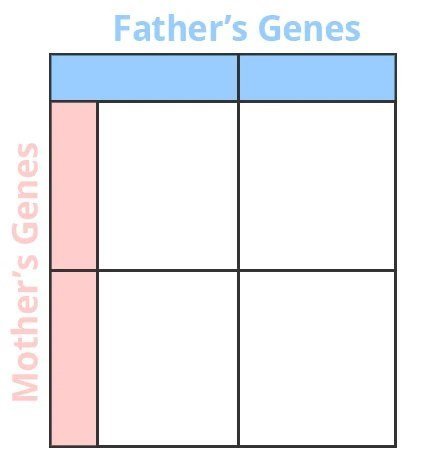
Each chromosome contains hundreds of *alleles (genes), each of which has the potential to influence the plant's development and physical expression.
When filling out a Punnett square, each *allele (trait) is either dominant or recessive; for simplicity, let's choose height; tall and short are both dominant, whereas capital T is recessive.
On the left, we always complete the mother's genes; on the right, we complete the father's genes. We will highlight the genes to make this easy to follow.
We begin by adding the mother's trait/s (allele) to the square, followed by the father's feature; the traits we have chosen are rather basic to make this exercise readable.
T = Tall
t = Short

Assume that the mother possesses both dominant and recessive genes, and that the father possesses both dominant and recessive genes.
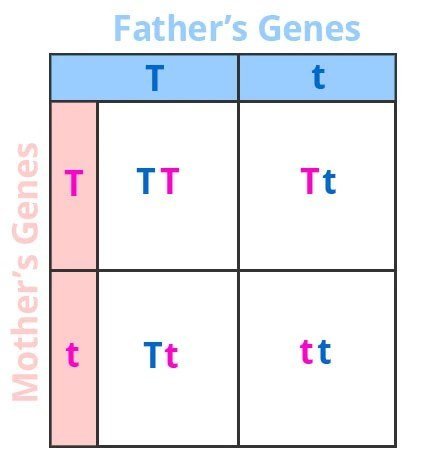
We can now see; after performing a test cross.
50% of the progeny will have both dominant and recessive traits (Tt)
25% of the progeny will show only dominant traits (TT)
25% of the progeny will only show recessive traits (tt)
Probabilities of offspring would be as follows:
50% (Tt) : 25% (TT) : 25% (tt)
Genotype ratio 1:2:1 – Phenotype ratio is 3:1
This may seem like a lot to learn… and it is. So let’s go over a few real-world examples:
Mendel investigated several features of peas, including seed color. He identified Yellow (Y) seeds as the dominant allele and Green (y) seeds as the recessive allele. When he crossed two "true breeding" parents of each type (YY x yy), he always obtained Yellow plants. These "true breeding" parents were homozygous for the Yellow and Green seed colors.
At first appearance, the children of these "True Breeders" were always Yellow (the dominant allele), making the recessive trait (Green) appear to be absent. However, when Mendel crossed the children (F1 generation), the Green characteristic reappeared! The F1 generation's offspring would have a 3:1 ratio of yellow to green seeds.
So what is going on? It's easiest to depict this with what we refer to as a "Punnett Square:"
EXAMPLE 1: SEED COLOR
With the first cross, it's possible to begin to understand what's going on and why the F1 generation is all yellow. Additionally, you can begin to understand why the F2 generation is experiencing a resurgence of green peas. The dominant trait (Yellow) takes precedence over the recessive trait (Green) until one of the F2 generation members is homozygous recessive (yy). A generation was "skipped" because to the Green characteristic. The genotype ranges from 1 YY to 2 YY to 1 YY.
EXAMPLE 2: BLOOD TYPE
Now things get a little more tricky, as we're going to incorporate something Mendel did not study: blood type! When it comes to blood type, we see the emergence of codominance, and we now have three alleles and four blood types:
Types of Blood
A-B-C-D-E-F-F-F-F-F-F
Blood Type O Alleles:
IA\sIB\si
With blood type, you'll observe that there are two dominant alleles and one recessive allele. IA and IB coexist. This indicates that if an individual possesses the genes IA and IB, he or she will have blood type AB. If an individual has two I alleles (ii), they will have Type O blood.
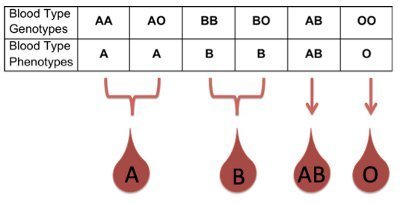
As with the peas, you can perform Punnett squares on each allele.
MULTIPLE ALLELES
This is the point at which things become truly difficult. As I'm sure everyone is aware, no gene lives in isolation from the others. Each individual is made up of numerous distinct genes, which Mendelian genetics and Punnett squares account for.
Now we must consider how reproduction occurs. Every parent, regardless of gender, endows their offspring with half of their DNA. These genes are passed along by gametes, such as sperm and eggs, to their children. To cross multiple alleles, we must consider what each gamete may be carrying. Each gamete inherits a random allele from the parent.
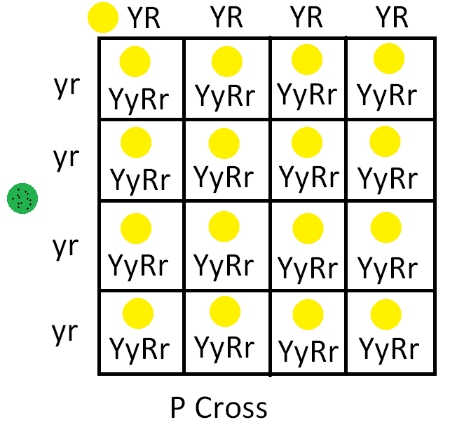
You'll note that each gamete is identical in this situation. This is due to the fact that both parents were homozygous for their respective features. However, if we combine the offspring, we have an entirely different portrait

On either side of the Punnett Square, several potential gametes from heterozygous parents are displayed. Each parent now has four potential gametes, rather than the two previously! As our Punnett square grows in size, the math becomes increasingly strange. Nine are yellow and round, three are yellow and wrinkled, three are green and round, and one is green and wrinkled. The problem is significantly more convoluted genetically.
You can continue to add genes and alleles, but as you can see, this can rapidly become extremely complicated. If you start introducing codominant features or sex-related traits, you're going to have a difficult time.
SEX-LINKED TRAITS
As you may know, males and females have distinct genetic characteristics. Men, for example, have a Y chromosome, while women have two X chromosomes. Men's Y chromosome frequently implies that they receive only one copy of an X chromosome gene from their mother, while the father provides a Y chromosome. As a result, men are more likely to have recessive sex-related features. One of the most notable examples is red-green colorblindness, which affects a large proportion of male children but is uncommon in female youngsters. Women who do not have colorblindness can carry the gene for red-green colorblindness.
Consider the following cross between a typical father (CY) and a carrier mother (Cc):
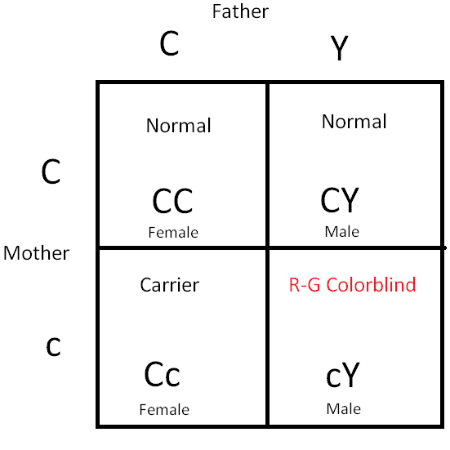
As you can see, men have a 50% chance of developing R-G colorblindness, while women can only be normal or carriers in this cross. Women can exhibit R-G colorblindness in just one way: if their father is colorblind and their mother is a carrier or colorblind.
Sme great info, and the best part is that this post will be here till the last witness runs a node. Which will only happen in the end of the world type of scenioro.
I remember this during biology class 😅. But its chromosomes X and Y, and possible traits/genes we can get dominant to our parent. I'm not clear though now, its been sooooooo long. 😖
Congratulations @bifbeans! You have completed the following achievement on the Hive blockchain and have been rewarded with new badge(s):
Your next target is to reach 2500 upvotes.
You can view your badges on your board and compare yourself to others in the Ranking
If you no longer want to receive notifications, reply to this comment with the word
STOPCheck out the last post from @hivebuzz: